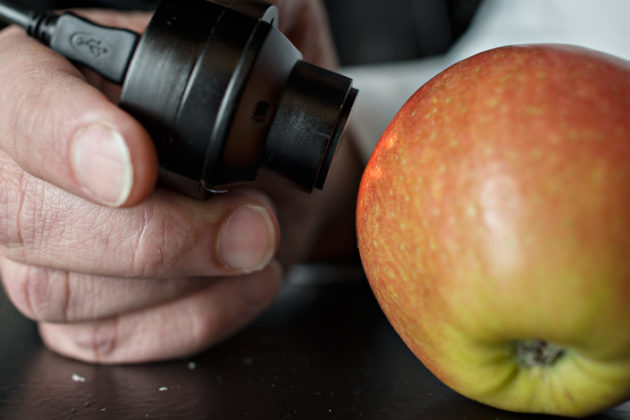Pocket-sized research

Numerous challenges in the food industry can now be solved by tiny gadgets. Senior scientist Jens Petter Wold has the future in his pocket – literally.
Everything gets smaller, and so do measuring devices. One example is MicroNIR – a pocket-sized instrument, developed in the USA. MicroNIR is a very compact, light and cost-effective near infra-red (NIR) spectrometer. New optical technology and miniaturization combined with high precision. 4.4 x 4.5 centimetres in size. Weight 60 grams.
“This is representative of a number of instruments of the same type. Soon you may have it on your smartphone if you want,” says Nofima researcher Jens Petter Wold.
Look on the inside
A spectrometer is an optical instrument that measures light intensity at different wavelengths. Such measurements are used to calculate the chemical composition of a food product with great accuracy. Currently spectrometers are used – albeit not the pocket-sized version – in the field of astronomy to analyse which elements a star contains, or in chemistry to study the detailed chemical composition of different substances.
As early as the mid-1990s Nofima started a basic research project aiming to develop robust measuring techniques and instruments for use in the production of food. Senior researcher Jens Petter Wold has been one of the driving forces since the beginning – when the instruments were unwieldy and their use was far more complicated and less accessible to the producers than the current micro editions bear witness of.

Nofima has taken part in developing online instrumentation for industrial use, including the QVision 500 for TOMRA. These measurements are now used worldwide to measure fat content in meat, fat content in salmon fillet, and to find the crabs with the highest meat content at Norway’s largest crab producer Hitramat. By using spectroscopy it’s possible to “look” inside the food products, not just the surface.
Lots of opportunities
The new micro-instruments, which one can take along anywhere, provide ample opportunities for measurements in the field. The result is revealed immediately.
“These micro-instruments vary in quality, but we have seen that this little fellow, for example, can measure the composition of grain and meat just as well as a larger laboratory instrument. Now we want to do a more comprehensive test. On fish, meat, fruit and all other types of food. For example bread dough – to determine when the kneading process is optimum. We want to use it to take samples of goods consignments or to carry out systematic quality measurements in a production process,” Jens Petter Wold says.
The food researcher with a great taste for innovation has yet to find out everything the little “NIR” may be used for, but Jens Petter Wold looks forward to exploring the opportunities.
“This is generic technology – technology that may have a number of applications. The instruments are not yet widely used, but we intend to change that. We intend to find out what it can be used for in food production at different stages. This will undoubtedly open up numerous opportunities for the food industry,” Wold says, picking up the semi-circular little thing, which easily fits between two fingers.
“In here there is a sensor. And here’s the light,” the researcher explains, pointing, before he closes his fingers around what actually is an advanced measuring device. The NIR easily fits in the palm of a hand.
“The fact that the technology has become so compact and handy makes us at Nofima want to contribute to develop its application in more areas,” Wold says.
The technology in the NIR is so advanced and so simple at the same time, that one by using the near infra-red light can stand next to conveyor belt and measure the content of food as it flies past: The amount of water in salted fish, the percentage of fat in meat or fish, the amount of protein in grain products.
Testing new technology
The scientist wants to apply the technology to conduct measurements both in the field and in production.
“We can see interesting and exciting opportunities with this new technology,” he concludes. “For example, we have an interesting collaboration with bear researchers, who’re going to use this to measure bear droppings in the woods! The measurement can tell whether the droppings came from a male or female – and that is important to a bear researcher.”
The investigation of MicroNIR is a part of Nofima’s strategic research programme “Spectral imaging of food quality,” and is linked to the research area dealing with fast scanning methods for quality assessment.
“A part of our basic project and our social mission in this research is to keep up to date on new technology and new instruments and test their applications. It’s really interesting,” the researcher claims.
He’s happy to accept enquiries from producers, the industry or others who happen to take an interest in the opportunities that arise through pocket-sized quality measuring instruments at an affordable price.
“One can of course acquire the technology oneself by ordering it from the manufacturer. Current prices are becoming affordable for more and more. But one can also send me an e-mail, stating which measurements one wants to do, and I’ll see what I can do,” Jens Petter Wold grins.
Contact person
Research areas
Quality and measurement methods
Topics
Spectroscopy
